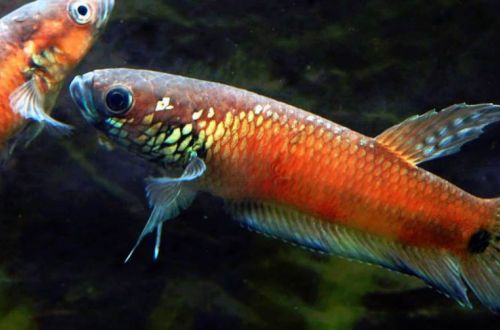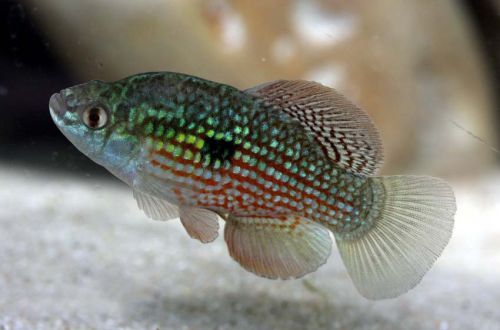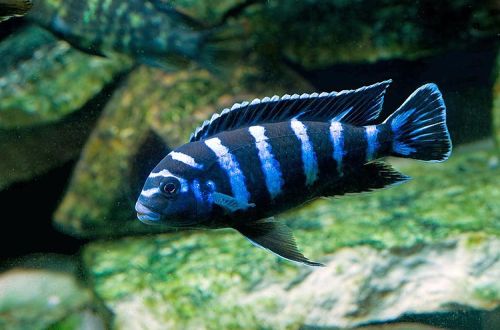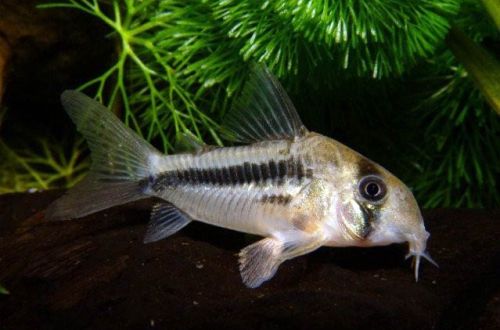
cockerel gladiator
Betta gladiator or Cockerel gladiator, scientific name Betta gladiator, belongs to the Osphronemidae family. This fish fully justifies its name, having pronounced fighting qualities – we are talking about fierce rivalry between males. Given the peculiarities of behavior and not simple maintenance, they are not recommended for beginner aquarists.

Contents
Habitat
It comes from Southeast Asia from the Malaysian part of the island of Borneo from its northern tip. Inhabits the basin of the Maliau River, located on a plateau surrounded by hills and overgrown with dense tropical forest. A typical biotope is a shallow, poorly lit reservoir in the depths of the jungle, the bottom of which is covered with a thick layer of plant material: fallen leaves, branches, snags, etc. The water has a rich brown color due to the high concentration of humic acids and other tannins formed in the result of organic decomposition.
Brief information:
- The volume of the aquarium – from 80 liters.
- Temperature – 22-27°C
- Value pH — 4.0–6.0
- Water hardness – 1–5 dGH
- Substrate type – any dark
- Lighting – subdued
- Brackish water – no
- Water movement – little or no
- The size of the fish is 8–9 cm.
- Food – any food
- Temperament – conditionally peaceful
- Content – alone, in pairs or in a group
Description
Adults reach a length of 8-9 cm. The fish has a strong strong body, short fins. The main color is dark red. Males, in contrast to females, look larger and brighter, and also have a wider head shape.
Food
Probably, in nature, they feed on small invertebrates and freshwater shrimp, sharing a habitat with Betta fish. In a home aquarium, dry, frozen and live food, which are popular in the aquarium trade, can become the basis of the diet. And the latter are preferred. For example, brine shrimp, daphnia, bloodworms, pieces of shrimp and earthworms are good choices.
Maintenance and care, arrangement of the aquarium
The optimal size of the aquarium for one pair of fish starts from 80 litas. The format doesn’t really matter. Some breeders keep it to a minimum and often don’t use a backing for ease of maintenance. However, it is desirable to form some shaded areas with driftwood and plants, or place decorative items that can serve as shelters. Like other representatives of the genus, Betta gladiator prefers dim lighting, so when decorating with live plants, shade-loving varieties should be preferred. Adding the dried leaves of some trees will give the design more naturalness. They will serve not only as a decorative element, but also become a source of tannins, giving the water a chemical composition similar to that in which fish live in nature.
An important condition for successful maintenance is a stable aquatic environment. It is necessary to maintain low pH and dGH values, to prevent the accumulation of waste products (important with a high-protein diet) that can disrupt the normal flow of the nitrogen cycle. The guarantor of maintaining the biological balance is the regular maintenance of the aquarium and the uninterrupted operation of the installed equipment. First of all, this applies to the filtration system.
Behavior and Compatibility
They belong to the group of fighting fish. Such an affiliation and the name of this species indicate the difficult nature of Gladiator Cockerels. Males are true fighters, fighting each other for position in the intraspecific hierarchy. Skirmishes often lead to injury. The probability of this is greatly increased if the males are in a small tank, devoid of shelters. Aggression can extend to the opposite sex and to other species that have a similar color and body shape. As a rule, females that have been recently added to the aquarium and are not familiar to the male are attacked. It is recommended to maintain a community of one male and one or more females with whom he grew up together, i.e. they should be acquired from the same lot, but not as different. The company can be made up of hardy species of comparable size or slightly larger.
Breeding / breeding
Breeding is fairly easy if the fish are in the right conditions and given a balanced diet. With the onset of the breeding season, the male forms a temporary pair with one of the females. As noted above, they should grow together to avoid compatibility issues. After a long courtship process, spawning begins, accompanied by a close embrace, during which the couple presses tightly against each other, wrapping themselves around their bodies. At the moment of climax, the eggs are released and fertilized. The male takes all the eggs into his mouth and will carry them throughout the entire incubation period, which lasts up to a month. This strategy of protecting offspring is common to many Betta species and ensures the survival of offspring in the hostile environment of tropical swamps. The male retires to a quiet place or hides in a shelter. At this time, he is most vulnerable, he should not be disturbed, otherwise he may accidentally eat his own brood or release unhatched eggs.
Fish diseases
The cause of most diseases is unsuitable conditions of detention. A stable habitat will be the key to successful keeping. In the event of symptoms of the disease, first of all, the quality of the water should be checked and, if deviations are found, measures should be taken to correct the situation. If symptoms persist or even worsen, medical treatment will be required. Read more about symptoms and treatments in the Aquarium Fish Diseases section.





